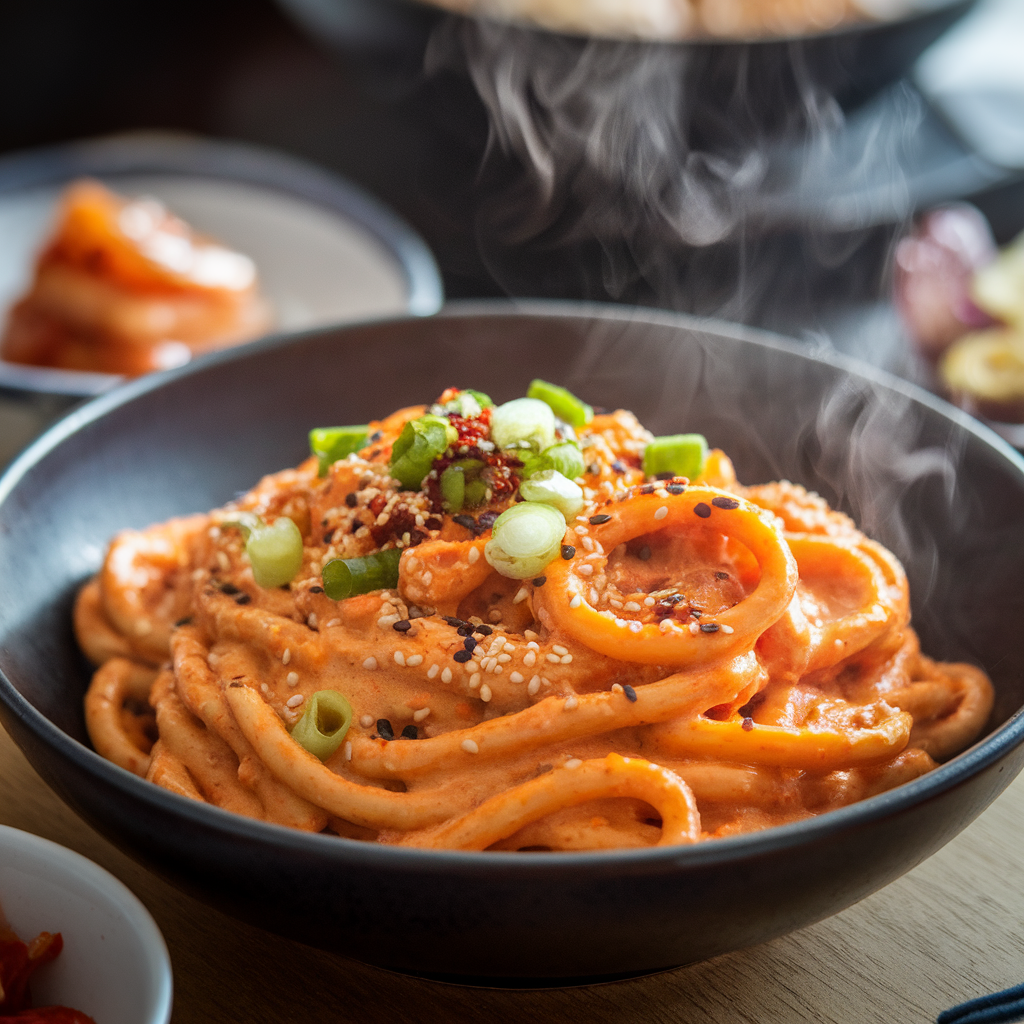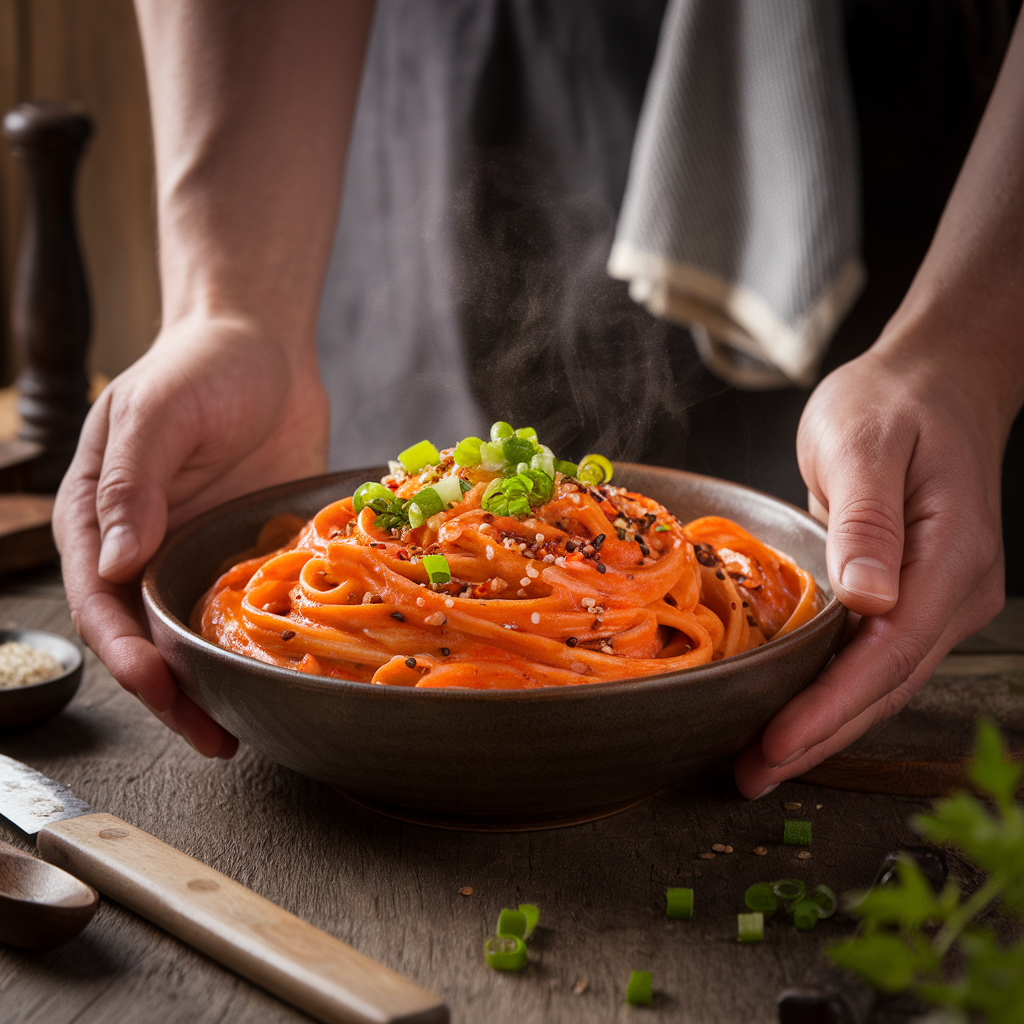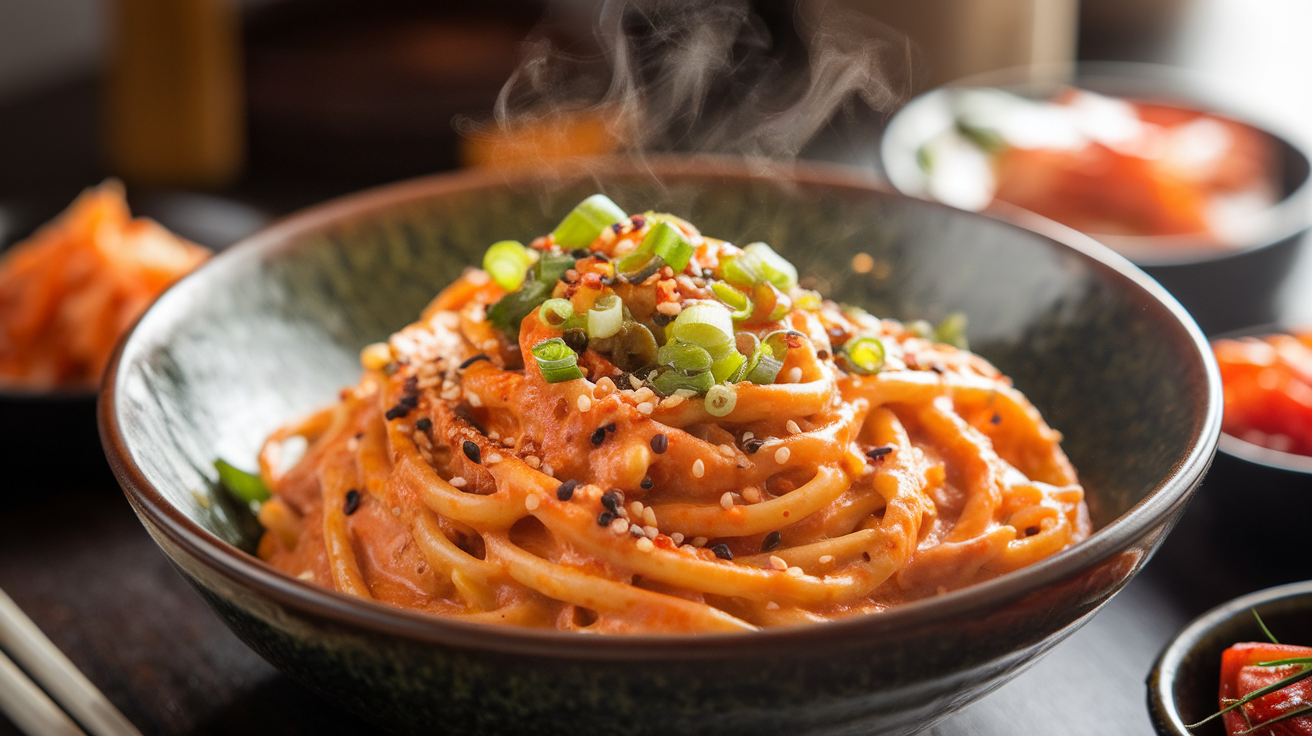A Bold, Comforting, and Flavor-Packed Korean Fusion Pasta Dish
Introduction
If you love dishes that blend heat with creaminess, you’re in for a serious treat. This Creamy Korean Gochujang Pasta combines silky noodles with a rich, spicy, umami-packed sauce made with gochujang, Korea’s iconic fermented chili paste. It’s fusion at its finest — where Italian comfort meets bold Korean flavor — and it’s incredibly simple to whip up at home.
Whether you’re a longtime lover of spicy food or just exploring Asian dish recipes, this pasta will introduce your taste buds to something new and deeply satisfying. Plus, it’s perfect for those asking, “What can I make with gochujang besides stir-fry?” The answer is this flavorful, creamy pasta — and once you try it, you’ll make it again and again.
What is Gochujang?
Gochujang (고추장) is a fermented chili paste that’s central to Korean cuisine. It’s made from gochugaru (Korean red chili flakes), glutinous rice, fermented soybeans, and salt. The result is a thick, deep-red paste that’s spicy, sweet, and slightly funky — a powerful base for sauces, stews, marinades, and dressings.
Unlike hot sauces that hit you with heat immediately, gochujang’s spice builds slowly, allowing the other flavors to shine. It’s also packed with umami, giving dishes a rich depth that lingers. Its versatility means it can adapt to many cuisines — especially when paired with creamy elements like in this pasta recipe.
Pourquoi Vous allez adorer Cette Recette
- Quick Weeknight Meal – Ready in under 30 minutes
- Comfort Food with a Kick – A spicy twist on classic creamy pasta
- Great Use for Gochujang – A new way to use your Korean pantry staples
- Personnalisable – Add veggies, protein, or go vegan
- Foule-Pleaser – Bold flavors that surprise and satisfy
Whether you’re cooking for yourself or feeding your family, this spicy, savory pasta is an instant favorite that doesn’t require any hard-to-find ingredients beyond the gochujang.
Ingrédients
Here’s everything you’ll need to make this spicy Korean pasta dish.
🧂 Pasta:
- 250g (9 oz) spaghetti, linguine, or fettuccine
- Salt, for boiling water
🔥 Gochujang Cream Sauce:
- 2 tbsp gochujang (adjust based on spice level)
- 1 tbsp la sauce de soja
- 1 tbsp vinaigre de riz (or apple cider vinegar)
- 1 tbsp l'huile de sésame
- 3 cloves l'ailémincé
- ½ small l'oignonhaché finement
- 1 tsp grated ginger (optional but adds great depth)
- 1 cup crème de lourdes ou full-fat coconut milk (for dairy-free)
- ½ cup vegetable broth ou reserved pasta water
- 1 tsp sucre, honey, or maple syrup (to balance the heat)
- Salt & pepper to taste

🥦 Veggie Add-ins (Optional but Recommended):
- 1 cup sliced mushrooms (shiitake, cremini, or button)
- 1 small courgettes, sliced into half moons
- 1 bell pepper, julienned
- 1 cup baby spinach ou kale
- 2 oignons verts, thinly sliced
- Toasted graines de sésame for garnish
Étape par Étape les Instructions
Etape 1: faire Cuire les Pâtes
Bring a pot of salted water to a boil. Cook your pasta until just al dente (firm to the bite), about 8–10 minutes. Drain, but reserve ½ cup of the pasta water. This starchy liquid helps loosen and emulsify the sauce later.
Step 2: Sauté the Aromatics & Veggies
In a large skillet or wok, heat sesame oil over medium heat. Add onions, garlic, and ginger. Sauté for 2–3 minutes until fragrant and soft. Toss in the mushrooms, bell peppers, and zucchini. Cook until they begin to soften, about 5–6 minutes. Add spinach or kale in the last minute just to wilt.
Step 3: Build the Sauce
Push veggies to one side or remove them temporarily. Add gochujang, soy sauce, vinegar, and sugar to the pan. Let the paste caramelize slightly for 1 minute to intensify its flavor.
Pour in cream (or coconut milk) and broth or pasta water. Stir until smooth and let simmer for 3–4 minutes to thicken. Season with salt and pepper to taste.
Step 4: Toss Pasta & Serve
Add the cooked pasta into the sauce, tossing thoroughly until every strand is coated. If it feels too thick, add a splash of pasta water. Return the veggies to the pan if removed. Mix well and heat everything together for 2 more minutes.
Step 5: Garnish
Serve hot, topped with sliced green onions and toasted sesame seeds. Optional: add a soft-boiled egg, shredded nori, or a sprinkle of parmesan for extra depth.

Flavor Profile
| Element | Saveur |
|---|---|
| Gochujang | Spicy, umami, sweet |
| Garlic & Onion | Savory & aromatic |
| Cream/Coconut Milk | Rich, silky, slightly sweet |
| Soy Sauce | Salty, earthy |
| Vinaigre De Riz | Tangy & bright |
| Légumes | Fresh, crunchy |
| L'Huile De Sésame | Nutty, toasty |
Together, these create a beautifully balanced dish: fiery, creamy, and comforting all in one.
Faire Votre Propre
➕ Add Protein:
- Fried tofu cubes for a plant-based meal
- Grilled chicken or shredded rotisserie chicken
- Crispy shrimp or calamari
- Fried or soft-boiled egg on top (Korean-style)
🍽️ Try Different Noodles:
- Udon noodles
- Ramen noodles
- Rice noodles
- Soba noodles
- Gluten-free pasta
🌱 Vegan Version:
- Use coconut milk or oat cream
- Add tofu, tempeh, or edamame for protein
- Skip cheese-based garnishes
What to Serve with Creamy Gochujang Pasta
Pair this dish with lighter sides to offset its richness and spice:
| Side Dish | Why It Works |
|---|---|
| Kimchi | Cuts through creaminess with tangy spice |
| Cucumber Sesame Salad | Refreshing and cooling |
| Pickled Radish or Carrots | Adds crunch and balance |
| Steamed Edamame | Protein-rich and mild |
| Miso Soup or Doenjang Jjigae | Complements the Korean flavor palette |

Storage & Meal Prep Tips
- Réfrigérateur: Store leftovers in an airtight container for up to 3 days.
- Reheat: Warm gently in a pan with a splash of broth or milk to loosen the sauce.
- La Préparation Des Repas: Keep sauce and pasta separate until ready to eat for best texture.
Fun Fact: Why Fusion Works So Well
Fusion recipes like this one combine global ingredients and techniques — in this case, Italian-style pasta avec Korean flavor components. This kind of cooking allows for creative expression and brings new life to familiar dishes. Gochujang pasta is a great way to enjoy simple Asian dishes in new forms, especially for those who want quick and modern recipes with a cultural twist.
Gochujang FAQ
Is gochujang very spicy?
Gochujang has a medium-level heat that builds. Most brands range from mild to medium-spicy. Start with less and increase as you taste.
Can I find gochujang in regular grocery stores?
Yes! It’s widely available now in Asian sections of most supermarkets, or online. Look for it in red tubs or glass jars.
Can I freeze gochujang?
Yes. It lasts months in the fridge, but you can also freeze it in tablespoon portions to thaw as needed.
Other Recipes That Use Gochujang
If you’ve bought a tub and aren’t sure how else to use it, here are ideas to try:
- Korean BBQ Marinade – Add gochujang to soy sauce, sesame oil, and garlic for an amazing meat marinade
- Gochujang Mayo – Mix with mayo for sandwiches, burgers, or sushi
- Gochujang Fried Rice – Stir into leftover rice with veggies and a fried egg
- Korean Meatballs or Tofu Bites – Glaze with gochujang, honey, and soy
- Spicy Gochujang Noodle Soup – Comforting and flavorful broth-based dish
Réflexions Finales
If you’re searching for a bold, comforting, and deeply flavorful meal that strays from the ordinary, Creamy Korean Gochujang Pasta is your answer. It brings together the spice of Korean cooking and the coziness of Italian pasta in one unforgettable dish. It’s creamy, spicy, quick, and endlessly adaptable.
Next time you’re staring at that tub of gochujang wondering what to make, you’ll know exactly what to cook. Gather your noodles, heat up your skillet, and prepare to fall in love with a bowl of comfort like no other.


